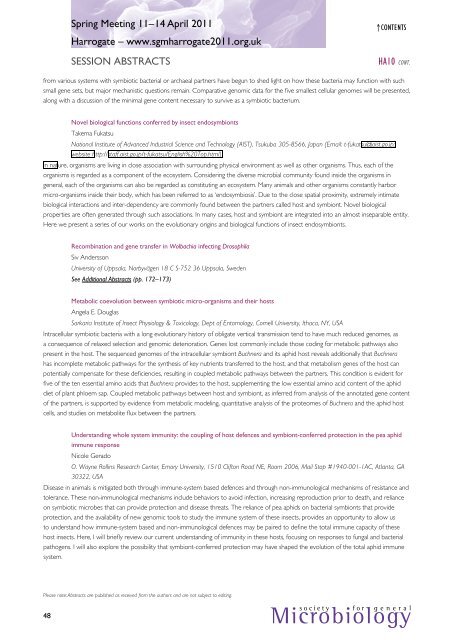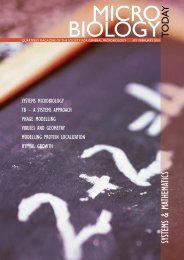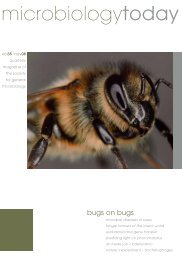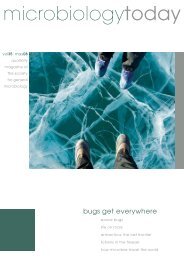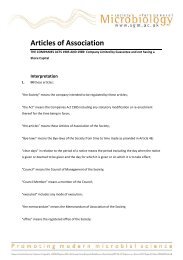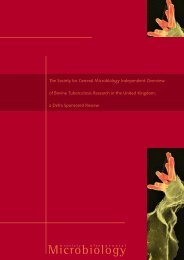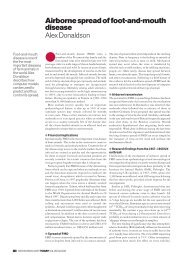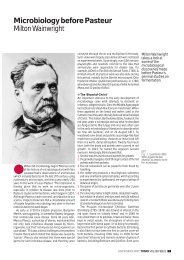Spring Conference 2011 - Society for General Microbiology
Spring Conference 2011 - Society for General Microbiology
Spring Conference 2011 - Society for General Microbiology
You also want an ePaper? Increase the reach of your titles
YUMPU automatically turns print PDFs into web optimized ePapers that Google loves.
Please note: Abstracts are published as received from the authors and are not subject to editing.<br />
48<br />
<strong>Spring</strong> Meeting 11–14 April <strong>2011</strong><br />
Harrogate – www.sgmharrogate<strong>2011</strong>.org.uk<br />
SESSION AbSTrACTS<br />
↑Contents<br />
HA10 Cont.<br />
from various systems with symbiotic bacterial or archaeal partners have begun to shed light on how these bacteria may function with such<br />
small gene sets, but major mechanistic questions remain. Comparative genomic data <strong>for</strong> the five smallest cellular genomes will be presented,<br />
along with a discussion of the minimal gene content necessary to survive as a symbiotic bacterium.<br />
Novel biological functions conferred by insect endosymbionts<br />
Takema Fukatsu<br />
National Institute of Advanced Industrial Science and Technology (AIST), Tsukuba 305-8566, Japan (Email: t-fukatsu@aist.go.jp;<br />
website http://staff.aist.go.jp/t-fukatsu/English%20Top.html)<br />
in nature, organisms are living in close association with surrounding physical environment as well as other organisms. Thus, each of the<br />
organisms is regarded as a component of the ecosystem. Considering the diverse microbial community found inside the organisms in<br />
general, each of the organisms can also be regarded as constituting an ecosystem. Many animals and other organisms constantly harbor<br />
micro-organisms inside their body, which has been referred to as ‘endosymbiosis’. Due to the close spatial proximity, extremely intimate<br />
biological interactions and inter-dependency are commonly found between the partners called host and symbiont. Novel biological<br />
properties are often generated through such associations. in many cases, host and symbiont are integrated into an almost inseparable entity.<br />
Here we present a series of our works on the evolutionary origins and biological functions of insect endosymbionts.<br />
recombination and gene transfer in Wolbachia infecting Drosophila<br />
Siv Andersson<br />
University of Uppsala, Norbyvägen 18 C S-752 36 Uppsala, Sweden<br />
See Additional Abstracts (pp. 172–173)<br />
Metabolic coevolution between symbiotic micro-organisms and their hosts<br />
Angela E. Douglas<br />
Sarkaria Institute of Insect Physiology & Toxicology, Dept of Entomology, Cornell University, Ithaca, NY, USA<br />
intracellular symbiotic bacteria with a long evolutionary history of obligate vertical transmission tend to have much reduced genomes, as<br />
a consequence of relaxed selection and genomic deterioration. Genes lost commonly include those coding <strong>for</strong> metabolic pathways also<br />
present in the host. The sequenced genomes of the intracellular symbiont Buchnera and its aphid host reveals additionally that Buchnera<br />
has incomplete metabolic pathways <strong>for</strong> the synthesis of key nutrients transferred to the host, and that metabolism genes of the host can<br />
potentially compensate <strong>for</strong> these deficiencies, resulting in coupled metabolic pathways between the partners. This condition is evident <strong>for</strong><br />
five of the ten essential amino acids that Buchnera provides to the host, supplementing the low essential amino acid content of the aphid<br />
diet of plant phloem sap. Coupled metabolic pathways between host and symbiont, as inferred from analysis of the annotated gene content<br />
of the partners, is supported by evidence from metabolic modeling, quantitative analysis of the proteomes of Buchnera and the aphid host<br />
cells, and studies on metabolite flux between the partners.<br />
Understanding whole system immunity: the coupling of host defences and symbiont-conferred protection in the pea aphid<br />
immune response<br />
Nicole Gerado<br />
O. Wayne Rollins Research Center, Emory University, 1510 Clifton Road NE, Room 2006, Mail Stop #1940-001-1AC, Atlanta, GA<br />
30322, USA<br />
Disease in animals is mitigated both through immune-system based defences and through non-immunological mechanisms of resistance and<br />
tolerance. These non-immunological mechanisms include behaviors to avoid infection, increasing reproduction prior to death, and reliance<br />
on symbiotic microbes that can provide protection and disease threats. The reliance of pea aphids on bacterial symbionts that provide<br />
protection, and the availability of new genomic tools to study the immune system of these insects, provides an opportunity to allow us<br />
to understand how immune-system based and non-immunological defences may be paired to define the total immune capacity of these<br />
host insects. Here, i will briefly review our current understanding of immunity in these hosts, focusing on responses to fungal and bacterial<br />
pathogens. i will also explore the possibility that symbiont-conferred protection may have shaped the evolution of the total aphid immune<br />
system.<br />
s o c i e t y f o r g e n e r a l<br />
<strong>Microbiology</strong>


